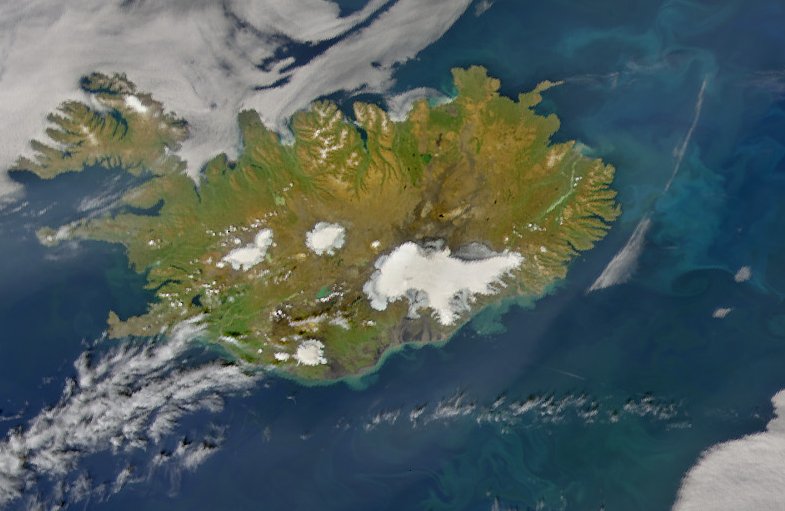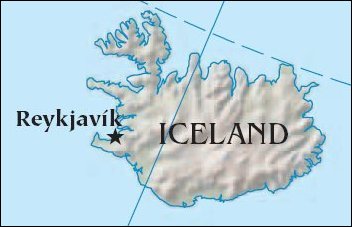| Earth from Space is a free eBook describing our planet from a satellite's perspective. Fore more information, please read the About pages. |

|

Home  Europe Europe  Iceland Iceland  Iceland Iceland |
|
| See also: Grimsvotn Volcano, Reykjavik | |






|
|
Phytoplankton around IcelandPosition of center of photo (Lat/Long): [64.56680/-18.60064] |
|
  The many shades of blue and blue-green in the true-color image above indicate that marine plant life (called phytoplankton) is in full bloom around Iceland. Phytoplankton form the foundation of the marine food chain and, ultimately, support almost all animal life forms in the ocean. Like land-based plants, phytoplankton require sunlight, water, carbon dioxide and nutrients in order to grow. During the summer months in the North Atlantic, the main limiting factor to growth is the availability of nutrients. Whenever a strong low-pressure system passes overhead, or a strong shift in current patterns stirs up the water from below, nutrients that have settled toward the bottom of the sea are brought up near the surface. As a result, phytoplankton can quickly reproduce by the trillions, creating beautiful patterns of light blue and turquoise that can extend for hundreds or even thousands of kilometers - features easily seen by space-based sensors. The many shades of blue and blue-green in the true-color image above indicate that marine plant life (called phytoplankton) is in full bloom around Iceland. Phytoplankton form the foundation of the marine food chain and, ultimately, support almost all animal life forms in the ocean. Like land-based plants, phytoplankton require sunlight, water, carbon dioxide and nutrients in order to grow. During the summer months in the North Atlantic, the main limiting factor to growth is the availability of nutrients. Whenever a strong low-pressure system passes overhead, or a strong shift in current patterns stirs up the water from below, nutrients that have settled toward the bottom of the sea are brought up near the surface. As a result, phytoplankton can quickly reproduce by the trillions, creating beautiful patterns of light blue and turquoise that can extend for hundreds or even thousands of kilometers - features easily seen by space-based sensors.
The color of the oceanís surface will vary according to the type of phytoplankton that is blooming. Just like their terrestrial cousins, phytoplankton contain the pigment chlorophyll, which they use for photosynthesis. The chlorophyll gives phytoplankton a greenish appearance and, therefore, many large-scale blooms take on a blue-green color when seen from above. However, some species of phytoplankton also produce a white calcium carbonate (basically chalk) exoskeleton. Known as coccolithophores, when these organisms bloom in large numbers they brighten the oceanís surface to a pale blue or even milky white. Judging by the colors in the top image, it is possible that a variety of species of phytoplankton were in bloom around Iceland on August 11, 2004, when these Sea-viewing Wide Field-of-view Sensor (SeaWiFS) data were acquired. |
| Source of material: NASA |
Further information: WikiPedia article on Phytoplankton around Iceland
Last Update: 2011-03-30

